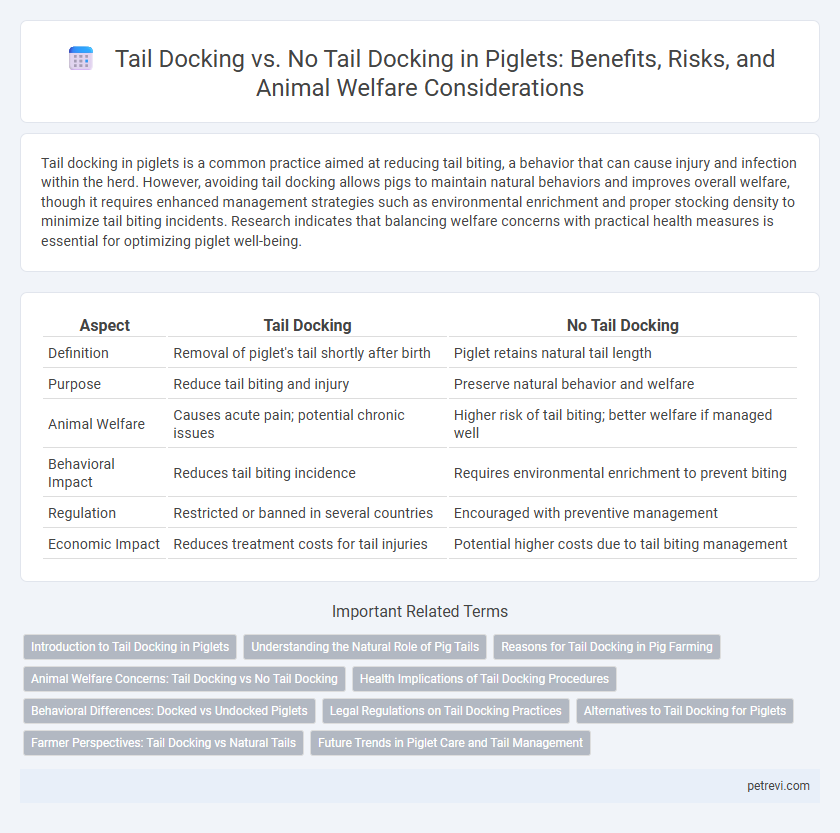Tail docking in piglets is a common practice aimed at reducing tail biting, a behavior that can cause injury and infection within the herd. However, avoiding tail docking allows pigs to maintain natural behaviors and improves overall welfare, though it requires enhanced management strategies such as environmental enrichment and proper stocking density to minimize tail biting incidents. Research indicates that balancing welfare concerns with practical health measures is essential for optimizing piglet well-being.
Table of Comparison
| Aspect | Tail Docking | No Tail Docking |
|---|---|---|
| Definition | Removal of piglet's tail shortly after birth | Piglet retains natural tail length |
| Purpose | Reduce tail biting and injury | Preserve natural behavior and welfare |
| Animal Welfare | Causes acute pain; potential chronic issues | Higher risk of tail biting; better welfare if managed well |
| Behavioral Impact | Reduces tail biting incidence | Requires environmental enrichment to prevent biting |
| Regulation | Restricted or banned in several countries | Encouraged with preventive management |
| Economic Impact | Reduces treatment costs for tail injuries | Potential higher costs due to tail biting management |
Introduction to Tail Docking in Piglets
Tail docking in piglets is a common husbandry practice aimed at reducing tail biting, a harmful behavior leading to injury and infection. The procedure involves the removal of a portion of the piglet's tail within the first few days of life, intending to improve animal welfare and reduce economic losses. However, concerns about pain and long-term effects have led to increasing scrutiny and alternatives that emphasize environmental enrichment and management changes.
Understanding the Natural Role of Pig Tails
Pig tails serve as important communication tools, expressing emotions like contentment or distress through movements and posture, which aids in social bonding and herd dynamics. Maintaining intact tails helps reduce stress and supports natural behaviors, contributing to overall welfare and reducing the incidence of tail biting among piglets. Tail docking, often practiced to prevent biting injuries, disrupts these natural functions and can lead to chronic pain and behavioral issues.
Reasons for Tail Docking in Pig Farming
Tail docking in piglets is primarily performed to prevent tail biting, a common behavior causing injuries and infections that compromise animal welfare and farm productivity. Farmers aim to reduce stress and aggressive interactions among pigs in confined environments where natural behaviors are limited. This preventive measure helps maintain herd health and minimizes economic losses associated with tail injuries and subsequent infections.
Animal Welfare Concerns: Tail Docking vs No Tail Docking
Tail docking in piglets, a common practice aimed at reducing tail biting, raises significant animal welfare concerns due to the pain and stress caused during the procedure. Choosing no tail docking can improve overall well-being by preserving natural behavior and reducing chronic pain, but it requires enhanced management practices to prevent tail biting incidents. Research highlights that environmental enrichment and proper stocking densities are critical to successfully implementing no tail docking while maintaining herd health.
Health Implications of Tail Docking Procedures
Tail docking in piglets reduces the risk of tail biting injuries, which can lead to infections and abscesses, thereby improving overall herd health. However, the procedure causes acute pain and stress, potentially impacting immune function and growth rates. Alternatives such as environmental enrichment and management strategies show promise in minimizing tail biting without the health drawbacks of docking.
Behavioral Differences: Docked vs Undocked Piglets
Undocked piglets exhibit more natural tail-in-mouth behaviors and engage in frequent social interactions, reflecting better stress coping mechanisms compared to docked piglets. Tail docking reduces tail biting incidents but may increase oral manipulation of other piglets, indicating potential welfare concerns. Behavioral studies highlight that undocked piglets maintain higher activity levels and show fewer signs of frustration, suggesting improved overall wellbeing.
Legal Regulations on Tail Docking Practices
Legal regulations on tail docking practices for piglets vary significantly across countries, with the European Union enforcing strict directives that limit routine tail docking to cases where evidence of tail biting exists despite improved environmental conditions. In the United States, no federal law mandates or prohibits tail docking, leaving the practice largely to industry standards and producer discretion. Compliance with these regulations involves regular monitoring and documentation to ensure that tail docking is performed only when absolutely necessary and under humane conditions.
Alternatives to Tail Docking for Piglets
Alternatives to tail docking for piglets include environmental enrichment, such as providing straw or other manipulable materials, to reduce tail biting behavior by satisfying pigs' natural exploratory needs. Improved management practices like maintaining optimal stocking density, proper ventilation, and balanced nutrition help minimize stress and aggression among piglets. Genetic selection for less aggressive traits also offers a sustainable approach to preventing tail biting without resorting to tail docking.
Farmer Perspectives: Tail Docking vs Natural Tails
Farmers often favor tail docking in piglets to reduce tail biting incidents, which can lead to infection and economic losses, while some advocate for natural tails to improve animal welfare and meet consumer demand for ethical farming. Tail docking requires careful management to avoid stress and pain, but proponents argue it minimizes costly injuries and treatment. Those supporting natural tails emphasize the importance of enrichment and proper housing to prevent tail biting without surgical intervention.
Future Trends in Piglet Care and Tail Management
Future trends in piglet care emphasize animal welfare and the reduction of tail docking practices through genetic selection for reduced tail biting and improved environmental enrichment. Advances in precision farming technologies enable continuous monitoring of piglet behavior to prevent tail biting incidents without the need for tail docking. Research on alternative management strategies, such as optimized nutrition and social grouping, supports sustainable tail management aligned with welfare-friendly farming standards.
Tail docking vs No tail docking for Piglets Infographic

 petrevi.com
petrevi.com